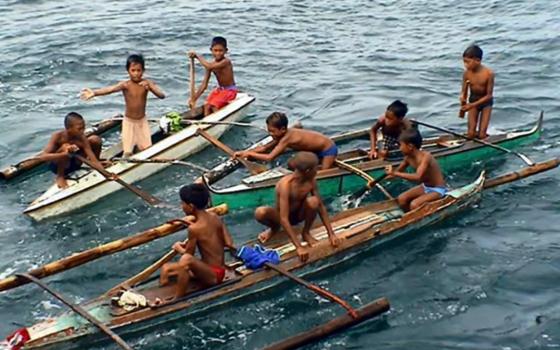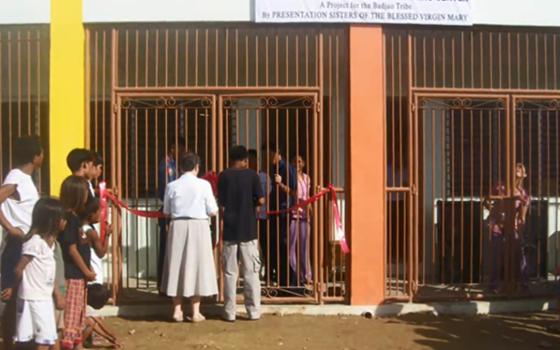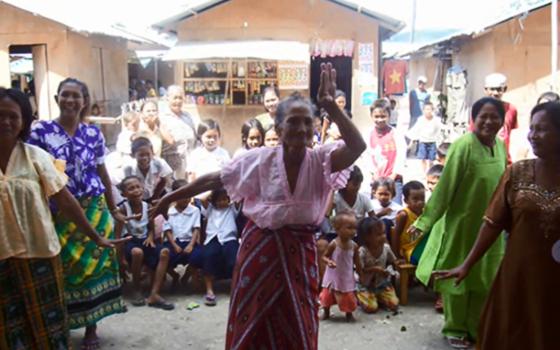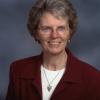I had not heard of sea gypsies until Sr. Evelyn Flanagan invited me to visit the community she has worked with since 1965 in Cebu, the Philippines. We climbed into a pedicab, a bicycle rickshaw powered by a human pedaler. The rickshaw's sidecar for passengers was extremely uncomfortable: a seat attached to a simple metal frame and canopy.
We bumped along the alley, passing small food stands, men selling roosters for cockfighting, small shops selling a variety of goods, and children taking baths. I marveled at the stamina and the strength of the young men's legs, which transport passengers of all heights and weights in sun, dust, rain and cold for little income. I felt exhausted just being a passenger.
When we arrived at the Badjao settlement, I learned that sea gypsies may have an exotic name, but their lives are far from glamorous. For centuries, they lived a nomadic, seafaring life by fishing and trading throughout the islands of the South Seas. Some lived in houseboats, and others lived in small houses on stilts over water inlets and traveled about in handmade fishing boats. Along with fishing, some became famous for their skills at diving for pearls. Even children were trained for this work.
However, in 1964, when trouble brewed between radical Muslims and others in Mindanao region of south Philippines, families began moving north to Cebu, a city in the Vasaya region of the Philippines. Many fled because they were Sufi Muslims who espoused both Islam and their tribal animistic religions, which was considered unacceptable to the more radical Muslim worshippers. Ten families made the first move to Cebu, where Sister Evelyn, a Sister of the Presentation of the Blessed Virgin Mary, and Fr. Frankie Connor, a Redemptorist missionary, became acquainted with them.
They found the families living in houseboats, but a year later, they built houses on stilts along the coast. When Sister Evelyn and Father Frankie met the tribal chief, Roberto Samasa, to discuss how they might be of assistance, he told them that education for their children was their first priority. Thus began an evolving development program for the Badjaos. As time passed, other fleeing families settled in the area, as well.
Adult literacy was one of the first programs Sister Evelyn and Father Frankie started to help adults adjust to their new environment. Traveling about on the open sea did not allow much time for education, so 97 percent of the community was illiterate. Next was a kindergarten for the little tots, and as the community grew, they organized a village council for self-governance. Leadership training is given to foster and maintain a deep sense of care for the entire community.
Things moved along for several years until 2005, when tragedy struck. A fire wiped out the entire community's properties. Families moved into tents, as did the education programs. Finally, after long negotiations with the local government, the community was given an area to develop, but, being near an inlet of the sea, it needed more land. Gradually, the government provided funds to build new stilt houses.
Sister Evelyn worked tirelessly with the community to meet these new challenges. With assistance from foundations and many donors from Ireland, she raised funds to build the Nano Nagle Child and Learning Center in 2008. This new building, a health clinic and a multipurpose center, became places of great hope for families who had lost everything. Livelihood programs were initiated for women and men to learn new skills that could generate income, although some still engaged in the traditional art of boat-building and fishing.
A Montessori kindergarten was eventually established. I have seen the tiniest children in many parts of the world benefit both academically and practically through this creative methodology. The hands-on approach to learning is such a different way of educating than the methods of traditional schools.
As the children matured, donors in Ireland raised funds that allowed them to go on to elementary school, high school and even college. About 12 youth now have university degrees. Two of them teach in the Nano Nagle Center, and others are the administrators of it. In 2016, three of these young women who worked at the center were sponsored by the International Presentation Association nongovernmental organization at the United Nations to advocate for indigenous peoples' rights and development.
Everywhere in the world the availability of housing is always less than the need, and the same issue was present here. Sister Evelyn secured funds to build quad houses, two-story duplexes on the new property that have one room on each floor. The village council decided which families would move into these new homes. However, adjusting to land living has not been easy for these families. They miss their life of freedom and their usual income from fishing and having to find other kinds of work to make a living.
While we were eating lunch at the center, we suddenly heard deafening music. Everyone laughed when they saw my puzzled expression and explained that some women were physically fighting and men were playing the loud music to get them to stop. When the music stopped, we knew the fighting had also ended. Although these fights are common and expected, the Badjaos are generally known as a peace-loving group. I imagine these altercations are the way women cope with frustrations, and there are many.
The area is crowded and the houses are small — one room for an entire family. There is unemployment, and conditions for laundry, cooking and keeping clean are limited. Outsiders sometimes judge them as lazy, but this is unfair in a country that has high unemployment rates and few opportunities for making a living. Many Filipinos leave families behind to find work abroad, but the Badjaos prefer to stay with their families and instead take courses offered at the center, hoping they will learn skills that can help them earn a living.
Life can be erratic, so people use music and dance to let go of frustrations and celebrate special feasts and rituals. They try to keep alive their traditions even though their seafaring lives are so different now. Children learn tribal dances when they can barely walk. Their dances include special hand and body movements that reflect the undulating waves of the sea, all part of their communal consciousness.
After a few hours with the Badjaos, I was inspired by their courage. They reminded me of the many people around the world who are being displaced from their usual lives, forced to find life in new places. They are making huge adjustments and trying to make the best of difficult circumstances, testimony to extraordinary resiliency and determination needed for survival.
[Joyce Meyer is a member of the Sisters of the Presentation of the Blessed Virgin Mary and GSR's liaison to women religious outside of the United States.]




